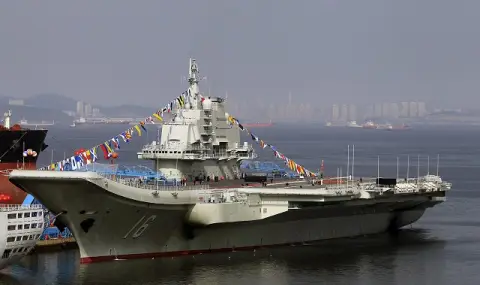China's defense spending has been growing for years. The country's warship fleet is also being intensively modernized and expanded. Is Taiwan at the root of this development and where are the weaknesses of the Chinese Navy still?
„Shandong" is the first aircraft carrier built entirely in China. It is based on the „Liaoning" - the first Chinese aircraft carrier. It was built in the Soviet Union, then purchased and completely rebuilt by China, recalls ARD in its extensive publication on the occasion of the Chinese military maneuvers that have begun off the coast of Taiwan.
The German public-law media also writes that an even larger Chinese aircraft carrier is currently being tested, and others are in the planning and construction process. Many details are unknown, as the Chinese state and party leadership keeps information about its military strictly confidential.
“There is a lot of speculation, but some things are known”, May-Britt Stumbaum, director of the geopolitical risk research consultancy “The SPEAR Institute” and a researcher at the Bundeswehr University in Munich, told ARD. “It has long been known that they are arming themselves”, she says. For example, according to the British International Institute for Strategic Studies, between 2014 and 2018 China acquired as many ships as Britain or Japan.
The number of warships is growing
The British institute has been monitoring the Chinese military for a long time and has found that the fleet is growing consistently. The US Department of Defense estimates that the number of Chinese warships this year will reach 400, including 65 submarines. In addition to hundreds of other support and transport ships, as well as aircraft under the command of the Navy.
The ARD notes that the US still has the most powerful navy in the world, but China has now surpassed the US in terms of numbers. “They already have the largest naval force in terms of numbers, but also the largest army in the world - with two million soldiers. To these are added 510,000 reservists, armed people's police and an increasing amount of equipment. "The Chinese defense industry really works in three shifts - 24 hours a day," Stumbaum told ARD.
At the annual meeting of the National People's Congress in early March in Beijing, the new defense budget was also discussed - this year's increase is 7.2 percent compared to the previous one. Premier Li Keqiang stressed to those present how important it is for the communist leadership to strengthen the army.
China will intensify military training and protect the country's national sovereignty and security, Li stressed. Defense must be supported at all levels with the goal of achieving "iron unity between the military, the government and the people."
Large-scale modernization of the army
Since taking office 12 years ago, Chinese head of state and government Xi Jinping has been working on a comprehensive modernization of the army. The goal is to turn it into a “world-class army" by mid-century.
But China has not tested its combat capability - decades have passed since the country last participated in a war, ARD notes. In order to learn from other countries, the Chinese military constantly participates in joint maneuvers with friendly countries, for example, with Russia. The aggressor in the war against Ukraine is a strategic partner of China. A joint exercise of the Russian, Chinese and Iranian navies took place very recently - in March.
At the same time, China's defense spending has been growing for years, ARD writes. It adds that the official military budget does not present the full picture - there are expenses that are not included in it or are at least not transparent. Money for China's coast guard, for example, is not included in the official military budget. In this regard, Mia Nowens of the International Institute for Strategic Studies told ARD: "We think that another 33 percent should be added to the defense budget to get a better idea of China's spending on the army". According to Nowens, last year the amount amounted to $304 billion.
But even so, China's military spending remains below two percent of GDP, says Nowens. That is, below what many other countries allocate for this purpose. If we talk in absolute numbers, China ranks second in military spending after the United States, which has a significantly larger defense budget.
Military maneuvers
However, the expansion and modernization of the Chinese military is certainly causing concern internationally. The People's Republic's navy and coast guard are acting increasingly aggressively - including in the South China Sea and around the democratically governed island of Taiwan, where the Chinese military regularly organizes large maneuvers.
The government in Beijing claims the island as its state territory, although Taiwan has never been under the control of the authoritarian ruling Communist Party in China, recalls ARD. The Chinese leadership has also set its sights on the waters around the island, says Nowens. "Analysis shows that Taiwan could be important for the further development of the capabilities of the Chinese military, respectively, the merger is important to the Chinese leadership."
The South China Sea is too shallow for Chinese submarines to operate there without being detected, Nowens also tells ARD. "We know that the Chinese Navy has focused heavily on developing its own defense technologies and submarine capabilities. This remains a weak point in modernization. But Taiwan's east coast offers immediate access to much deeper waters and could contribute to the improvement of the deep-sea fleet."
